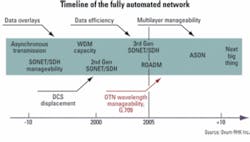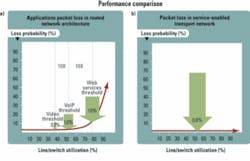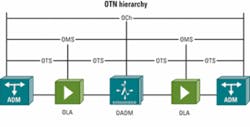Service-enabled networks aid convergence
by Andy McCormick
Today, network operators continue to seek convergence of their networks to reduce operational expenses and eliminate unnecessary additional capital expenditures on multiple parallel networks. Driven by the need for rapid returns on investments (ROIs), telecom carriers are integrating a variety of services including residential broadband, advanced enterprise data connectivity, and video into existing voice networks while cable operators are adding voice over IP (VoIP) and advanced enterprise data services to the existing video and residential broadband infrastructure. At the same time, there is a massive migration from traditional SONET/SDH-based TDM services to IP/Ethernet-based services, including voice, video, Internet access, and Layer 2 business services.
The migration is not without its challenges and risks, especially when you consider supporting converged services without stranding investments. This task requires the development of a service-enabled transport network designed to handle VoIP, video, and data traffic as well as standard voice without sacrificing the performance network operators have come to depend on from their TDM-based networks.
The ITU G.709 Optical Transport Network (OTN) standard has emerged as a vehicle to enable such convergence and to provide a common and SONET/SDH-like operational model for network administration, performance monitoring, and fault isolation without altering the individual services. As Figure 1 shows, the development of OTN is a critical step in developing a fully automated network. Using OTN, multiple networks and services such as legacy SONET/SDH, Ethernet, storage protocols, and video can all be combined on to a common infrastructure-and even onto a single wavelength.
Transport network requirements from a network operator’s perspective are simple-consistent, deterministic, and low-latency performance regardless of the load placed on the network. Inherent in that is the ability to scale to meet increased demand. With that in mind, let’s examine the two fundamentally different architectures being used to solve the needs of emerging applications like VoIP, broadcast video, web-enabled business services, and networked remote storage.
One method of building a network to deliver advanced services leverages a routed network architecture. This architecture relies on routers to identify and prioritize the various traffic types. It looks deep inside the contents of packets and makes switching decisions based on what it finds.
The second method, the service-enabled transport network, focuses on delivering transparent connections for each service, alleviating the need for prioritization and improving the performance of the network. The critical difference, of course, is that routed networks operate at ISO Layers 3 and above, where they are easily affected by demand spikes. Service-enabled transport networks operate at Layers 1 and 2, where performance is far more deterministic and easily controlled.The approach of intrusively inspecting each packet is complex and problematic in many ways. At each switching point of a routed network, no matter how efficient it is, a complex set of instructions has to be executed and bits have to be transferred into and out of memory buffers-adding delay and latency. Figures 2a and 2b compare how the level of demand affects performance (as a function of packet loss) of routed and service-enabled transport networks, and the thresholds at which routed networks become untenable for different types of services.
Routed networking proponents argue that they can get by with less WAN bandwidth; but this argument fails when the network is under the least bit of stress. During periods of peak load, high-priority packets are transmitted at the expense of lower-priority packets. Those lower-priority packets are lost, triggering packet retransmissions that in turn also can be bounced, leading to even more packet retransmissions. With all of this occurring, network latency increases and application performance decreases.
To overcome these obstacles, routed networking users will eventually need additional bandwidth. In fact, public network operators will be forced to upgrade their routed network to meet service-level agreements. At that point, the bandwidth required by a routed network will be similar to the amount of bandwidth the service-enabled transport network is already providing-which means the expenditure of considerable time and hands-on technical resources getting there. In fact, based upon a study Ciena has conducted, the routed network cost of ownership is 30% higher than a service-enabled transport network.Service transparency is another major advantage for service-enabled transport networks as it allows a client device to maintain visibility across the network. Because routed networks have limited bandwidth to work with, they attempt to manipulate the data streams by removing idle frames, limiting packet length, and changing frame IP and MAC addresses as attempts to “tune” the network and optimize performance. The problem is that when frames or packets are manipulated, the client devices lose management visibility so there is no guarantee that the service at the termination point is the same as the service that was originated.
The service-enabled transport network does not have these issues because it has sufficient, reconfigurable bandwidth that it can dedicate to each service or application. Each frame or packet is “wrapped” in an OTN envelope and all processing and management is done on the OTN header, meaning all client header information is maintained. This is discussed in more detail below.
Last, there is the security issue. Routers can look inside a packet’s contents. As such, they are the ideal vehicle for hackers to penetrate the network. Because OTN operates at Layer 1 of the ISO stack, there is no packet inspection that hackers can exploit. Also because it is Layer 1, services from different client devices remain isolated from one another rather than mingled in a common data stream. This attribute makes it far more difficult to compromise an entire network.
At this point, it’s clear that transparent service-enabled transport networks are the superior approach for today’s performance-sensitive services. They perform better than routed networks, are unaffected by network utilization levels, do not require continuous tuning, and are more secure. More important, service-enabled transport networks can be used for any service type-including TCP/IP, MPEG, and storage protocols-regardless of their performance requirements because of the unique capabilities OTN brings in providing a common transport layer.
The key to understanding OTN can be summed up in one word-transparency-which makes it the ideal technology to build a converged network. OTN, or “digital wrapper” as it is sometimes called, is an ITU standard that was unified from competing standards being developed in the ITU and ANSI.
As end users continue to deploy increasingly complex networks using multi-service provisioning platforms and routers, they are losing service transparency because they cannot access SONET/SDH overhead bytes or the data communications channel (DCC) that carries all the management bytes and inter-nodal communications used to determine network paths and link states. A traditional SONET/SDH network will strip out these bytes and break the end-to-end communications and topology discovery. OTN supports its own separate overhead for performance monitoring and fault signaling, as well as a general communications channel (GCC) for remote management, software downloads, and other control functions.
OTN specifications provide for a robust management overhead analogous but superior to SONET/SDH using six levels of performance monitoring for advanced fault isolation and service-level management; therefore, network operators do not have to sacrifice the ability to manage at both the payload and service levels. In fact, an OTN payload can fully encapsulate a SONET/SDH frame without terminating the SONET DCC so that remote add/drop multiplexers (ADMs) can continue to be managed in the same manner, and topology discovery will still work between customer equipment.However, OTN does much more than transparently transport SONET/SDH. It is also highly effective in supporting asynchronous data services such as Gigabit Ethernet (GbE), 10GbE, all speeds of Fibre Channel, ESCON, and FICON that do not have the same physical-layer performance monitoring capabilities and fault isolation necessary for a high quality of service. Through its advanced performance monitoring, OTN brings those capabilities to asynchronous services without sacrificing the qualities that make those services attractive in the first place, such as low cost and ease of installation.
OTN is also the only transport layer that can carry a full 10GbE LAN PHY-the standard interface on IP/Ethernet equipment-including any and all vendor-proprietary overhead bytes that the routers use for additional control and management. This is a critical feature since, with the rapid migration toward IP/Ethernet-based infrastructure, it is essential that there be a seamless interface between the service layers (Layers 2 and 3) and the transport layers (Layers 0 and 1) so that there is no disruption of the functions these layers are designed to perform.
The inherent flexibility of OTN is enabled by its ability to extend this transparency to the timing plane. This ability allows the mixing of both synchronous and asynchronous signal types on a common wavelength. Moreover, synchronous services with different clock sources can be transported side by side, something not possible in a SONET/SDH network.
An OTN network is made up of several networking layers. The service layer represents such end-user services as GbE, SONET/SDH, Fibre Channel, or any other protocol. For asynchronous services such as ESCON, GbE, or Fibre Channel, the service is passed through a Generic Framing Procedure (GFP) mapper. The optical channel payload virtual container (OPVC) handles mapping the service into a uniform format. The optical channel payload tributary unit (OPTU) maps the output of the OPVC into a timeslot and performs timing adaptations to unify the clocking. The optical channel payload unit (OPU) contains all of the timeslots in the OTN frame. The optical channel data unit (ODU) provides the path-level transport functions of the OPU. The optical transport unit (OTU) provides the section-level overhead for the ODU and provides the GCC0 bytes. The physical layer maps the OTU into a wavelength or WDM system.
As shown in Figure 3, OTN has a hierarchy just like SONET and SDH. An optical channel (OCh) runs between anything that maps a service into an OTU1/OTU2 signal, typically a terminal unit. An optical multiplex section (OMS) is bounded by two devices that can multiplex wavelengths onto a fiber, such as a passive filter. An optical transmission section (OTS) is the fiber between anything that performs an optical function on the signal, such as an EDFA.
OTN is the common optical backbone network of the future. It is ideally suited to the creation of service-enabled transport networks that can support both existing TDM-based applications like circuit-switched voice and best-effort Internet access where packet latency is not an issue, as well as rapidly emerging applications such as VoIP, broadcast video, web-enabled business services, and networked remote storage. The very existence and future success of these advanced services is dependent on having access to low-latency, deterministic bandwidth.
Compared to a routed network architecture, the service-enabled transport network has far greater ability to support these delay-sensitive applications even when network utilization levels are high so that the network delivers consistent performance without having to constantly tune it. It also has significant advantages in terms of network security, virtually eliminating the threat of a network being hacked because it does not touch the underlying services or applications.
With OTN as its basis, the service-enabled transport network offers a low cost, services-centric alternative to network convergence. It supports a wide variety of new and emerging services and their stringent performance requirements without sacrificing support for legacy services. It further extends SONET/SDH-like OAM and FCAPS capabilities to data services including Ethernet, digital video, and storage protocols. Since OTN allows for mapping all services into a common wavelength-or set of wavelengths-it simplifies everything from monitoring and deployment to sparing and capacity management. And unlike SONET/SDH, it is the only transport layer that carries a full 10GbE LAN PHY, the standard interfaces of next-generation IP/Ethernet networks.
Andy McCormickis product marketing manager at Ciena (www.ciena.com).



